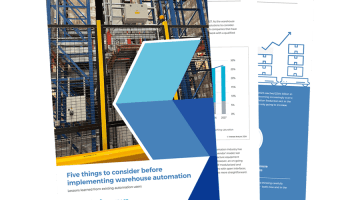Automation is Reshaping the Supply Chain
Over the last decade, corporate sustainability has come into focus for many companies. This shift has become more apparent as supply chain awareness, consumer expectations and demand increases. To achieve supply chain sustainability, companies can start by making small, iterative steps in their distribution facilities to enhance operations by reducing waste, refining processes, and decreasing their environmental impact.
Let Data Be Your Guide
In an eCommerce-driven world where shoppers purchase an item online and expect same-day or next-day delivery, warehouse throughput demands, and efficiency pressures are high. A good initial approach to improving efficiency and reducing waste within the four walls is to simplify your operational processes and analyze data to reveal inefficiencies. Examine each step from order receipt, through picking, to outbound loading. Where are there repetitive or non-value-add steps that can be removed? Utilize analytics, AI tools and machine learning to continually refine and improve processes.
You can also examine how new technologies optimize space utilization and streamline operations, especially in today’s labor constrained environment. Robotic unit sortation systems such as t-Sort or Goods-to-Person systems such as AutoStore speed fulfillment in a reduced footprint, demonstrating the very definition of space efficiency. AS/RS systems by design deliver high density storage, achieving much greater capacity to store products in a space-saving grid. Each step you take to reduce wasted effort, speed order fulfillment, and enhance overall operational flow builds sustainability.
Going Green
Consumers are more aware than ever on how goods are sourced, manufactured and distributed. Decreasing the environmental impact of your supply chain can start with changes at one facility. Even without LEED certification, your distribution center can become more aware of water usage and enact efforts to reduce water use. Examine your current energy needs for ways to reduce lighting, heating and cooling needs in your facility. Where are areas to conserve energy, such as installing motion-detection lighting or high-capacity fans that can reduce your facility’s carbon footprint?
Another consideration for reducing your operation’s energy needs is evaluating the efficiency of your materials handling systems. High-density AS/RS systems maximize valuable storage space and decrease the need for heating and cooling in additional square footage. Robotic Goods-to-Person systems such as Geek+, OTTO or AutoStore use very little power as they speed order fulfillment and automate product movement. The robots atop a high-density storage grid can operate without lighting and consume very little energy. In fact, a system with 10 robots will use the same amount of energy as a vacuum cleaner. Distribution leaders must build sustainability by leveraging new technologies that balance operational efficiency with a lower carbon footprint.
The focus on supply chain sustainability will escalate in the future and must keep pace with growing consumer demand for faster order fulfillment. By implementing new technologies and processes that reduce waste and decrease overall environmental impact, distribution centers can improve throughput and productivity while building sustainability.
Interested in learning more about Automation? Read more on Grocery Automation
Categories (tags):


